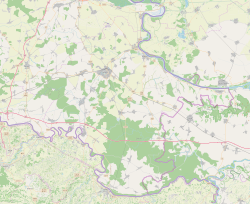Ludvinci (Serbian Cyrillic: Лудвинци) is a village located in the municipality of Trpinja, Vukovar-Syrmia County, Croatia. The settlement was originally established as a pustara, a Pannonian type of hamlet.[4] It was a colonist settlements established during the land reform in interwar Yugoslavia.[5]
Ludvinci
| |
|---|---|
 Location of Ludvinci in Croatia | |
| Coordinates: 45°24′11″N 18°49′26″E / 45.40306°N 18.82389°E | |
| Country | |
| Region | Slavonia (Podunavlje) |
| County | |
| Municipality | Trpinja |
| Government | |
| • Body | Local Committee |
| Area | |
• Total | 4.5 km2 (1.7 sq mi) |
| Population (2021)[3] | |
• Total | 79 |
| • Density | 18/km2 (45/sq mi) |
| Demonym(s) | Ludvinčanin (♂) Ludvinčanka (♀) (per grammatical gender) |
| Time zone | UTC+1 (CET) |
| • Summer (DST) | UTC+2 (CEST) |
| Postal code | 32 225 |
| Area code | +385 (0)32 |
| Vehicle registration | VU |
| Official languages | Croatian, Serbian[1] |
Name
editLanguages
editSerbian language
editSerbian Language and Serbian Cyrillic alphabet is the second official language in most of the villages of the Municipality of Trpinja (except Ćelije) alongside the Croatian language which is official at the national level.[6] Both Serbian and Croatian language are standardized varieties of the pluricentric Serbo-Croatian language. According to the Municipal Statute, individuals who are members of the Serbian national minority are ensured the freedom of expression of national belonging and freedom to use their language and script in public and private use on the whole territory of the Municipality including the village of Ludvinci.[6] The statute guarantees that the Serbian Cyrillic alphabet will be used in the same font size as the Latin alphabet in the text of the local seals and stamps, on official plates of public representatives, executive and administrative bodies, as well as on those of legal persons with public authorities.[6]
According to the municipal Statute, bilingual signs of the same font are used for written traffic signs and other written traffic markings, street and squares names and names of settlement and geographical localities on the entire territory of the Municipality.[6] Equal public use of Serbian language is required on the basis of the Constitutional Act on the Rights of National Minorities in the Republic of Croatia and relevant national laws and the country is a party to the European Charter for Regional or Minority Languages.[1]
See also
editReferences
edit- ^ a b c Government of Croatia (October 2013). "Peto izvješće Republike Hrvatske o primjeni Europske povelje o regionalnim ili manjinskim jezicima" (PDF) (in Croatian). Council of Europe. p. 36. Retrieved 26 March 2019.
- ^ Register of spatial units of the State Geodetic Administration of the Republic of Croatia. Wikidata Q119585703.
- ^ "Population by Age and Sex, by Settlements" (xlsx). Census of Population, Households and Dwellings in 2021. Zagreb: Croatian Bureau of Statistics. 2022.
- ^ Barišić Bogišić, Lidija (2022). O neslavenskom stanovništvu na vukovarskom području. Hrvatska sveučilišna naklada. p. 142. ISBN 978-953-169-497-1.
- ^ Šimončić-Bobetko, Zdenka (1990). "Kolonizacija u Hrvatskoj 1919.—1941. godine" [Colonization in Croatia Between 1919 and 1941]. Povijesni prilozi (in Croatian). 9 (9). Zagreb: Hrvatski institut za povijest: 160–162. ISSN 0351-9767.
- ^ a b c d "Statut Općine Trpinja" (PDF). Retrieved 15 November 2022.






